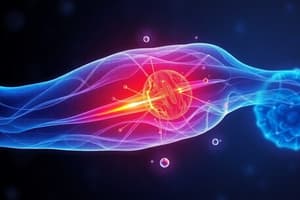Podcast
Questions and Answers
Which phase of muscle injury repair occurs first and involves neutrophils?
Which phase of muscle injury repair occurs first and involves neutrophils?
- Regeneration
- Degeneration (correct)
- Hemostasis and hematoma formation
- Inflammation
What is the primary role of cytokines during muscle repair?
What is the primary role of cytokines during muscle repair?
- To enhance resistance to oxidative stress and facilitate muscle healing (correct)
- To promote fibrosis rapidly
- To maintain cellular integrity exclusively
- To initiate immune response only
What must remain intact for proper regeneration of muscle after injury?
What must remain intact for proper regeneration of muscle after injury?
- Basement membrane (correct)
- Hemoglobin levels
- Satellite cells only
- Cytokines
During which period do T-lymphocytes dominate in the muscle repair process?
During which period do T-lymphocytes dominate in the muscle repair process?
What effect does fibrosis have on muscle function post-repair?
What effect does fibrosis have on muscle function post-repair?
Flashcards are hidden until you start studying
Study Notes
Muscle Strain and Contusion Repair Process
- Hemostasis and Hematoma Formation: Initial response to injury involving blood clotting and collection of blood at the injury site.
- Degeneration:
- Necrosis: Cell death occurs; neutrophils are the first immune cells to arrive at the injury site.
- Chemotactic Agents: Released to attract additional inflammatory mediators for further response.
- Inflammation:
- Initiates within 24-48 hours post-injury; essential for clearing debris and initiating repair.
- Phagocytosis: Macrophages clean up cellular debris left from necrosis.
- Satellite Cells Activation: Macrophages stimulate satellite cell migration and differentiation, crucial for muscle regeneration.
- T-lymphocytes: Predominate after macrophages’ role diminishes; they also release various cytokines supporting the healing process.
- Regeneration:
- Occurs approximately 6-8 weeks after injury, leading to the formation of new muscle fibers.
- Remodeling: Follow-up process to improve tissue structure and function post-regeneration.
- Fibrosis: Potential result of the repair process; characterized by excessive scar tissue formation, leading to less functional muscle.
Role of Basement Membrane in Muscle Healing
- Integrity of Basement Membrane: Essential for successful muscle regeneration; needs to remain intact.
- Satellite Cells Division: Critical for maintaining basement membrane integrity, aiding in muscle repair.
- Satellite cells merge with myogenic cells and fuse with remaining muscle fibers to restore functionality.
- Impact of Damage: If the basement membrane is compromised, fibrotic tissue develops, resulting in:
- Loss of muscle function.
- Increased risk of re-injury due to structural weakness.
- Satellite Cells Division: Critical for maintaining basement membrane integrity, aiding in muscle repair.
Effects of Cytokines on Satellite and Muscle Cells During Repair
- Enhanced Resistance to Oxidative Stress: Cytokines improve cell survival during injury recovery by mitigating oxidative damage.
- Inhibition of Myofibrogenesis: Blocking this process can enhance overall muscle healing efficiency.
- Proliferation Promotion: Cytokines encourage active cell division, facilitating tissue regeneration.
- Differentiation Support: Cytokines aid satellite cells in fusing with myofibers, promoting muscle fiber formation.
- Angiogenesis Stimulation: Increases vascular supply to newly formed muscle cells, ensuring they receive adequate nutrients and oxygen for recovery.
Studying That Suits You
Use AI to generate personalized quizzes and flashcards to suit your learning preferences.




